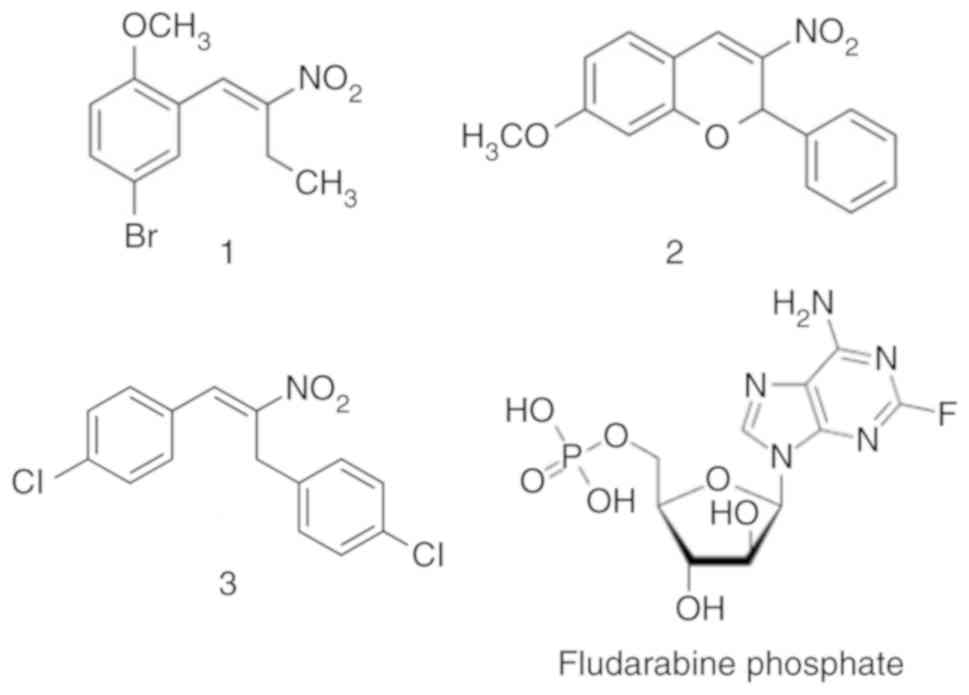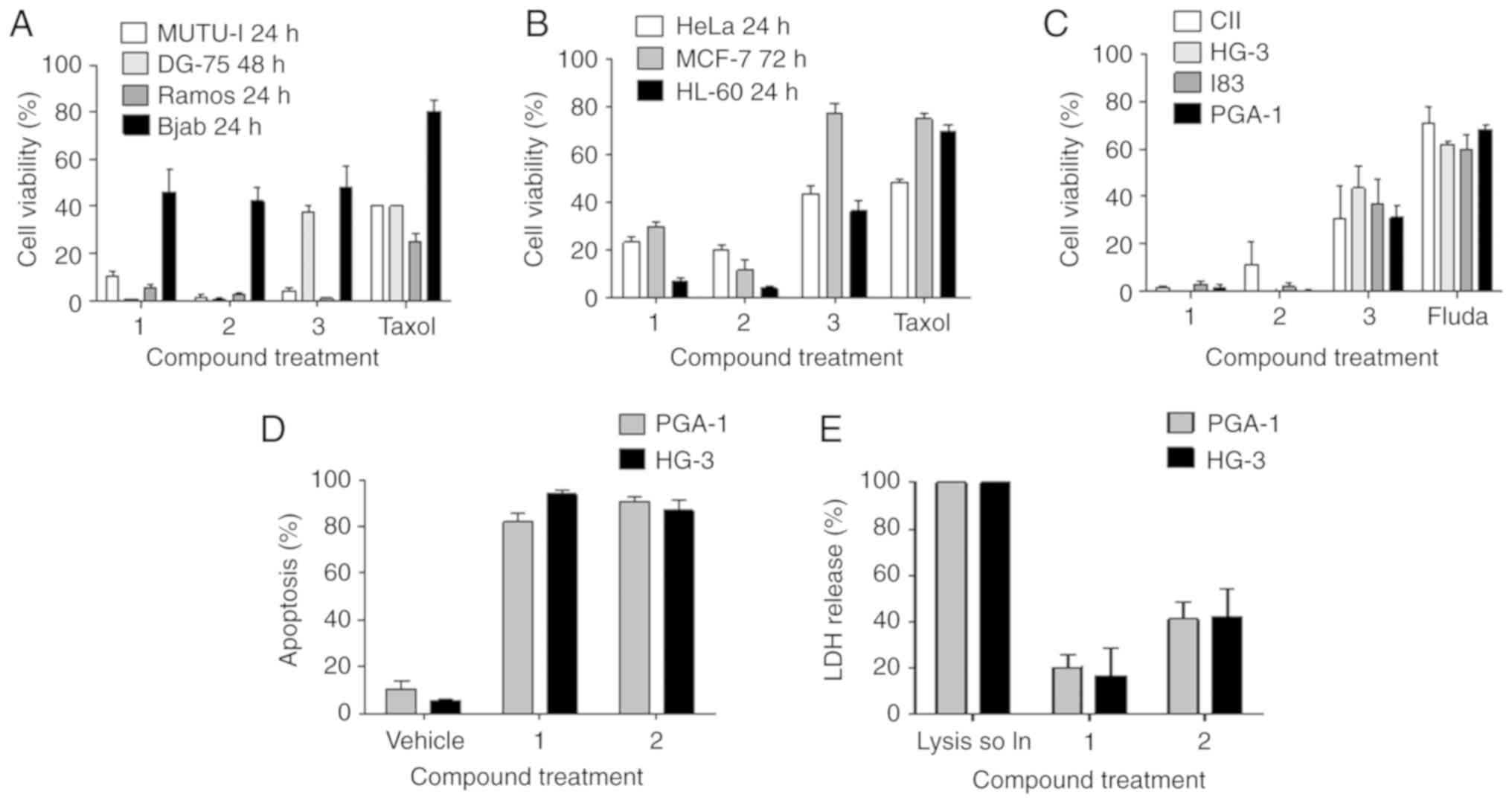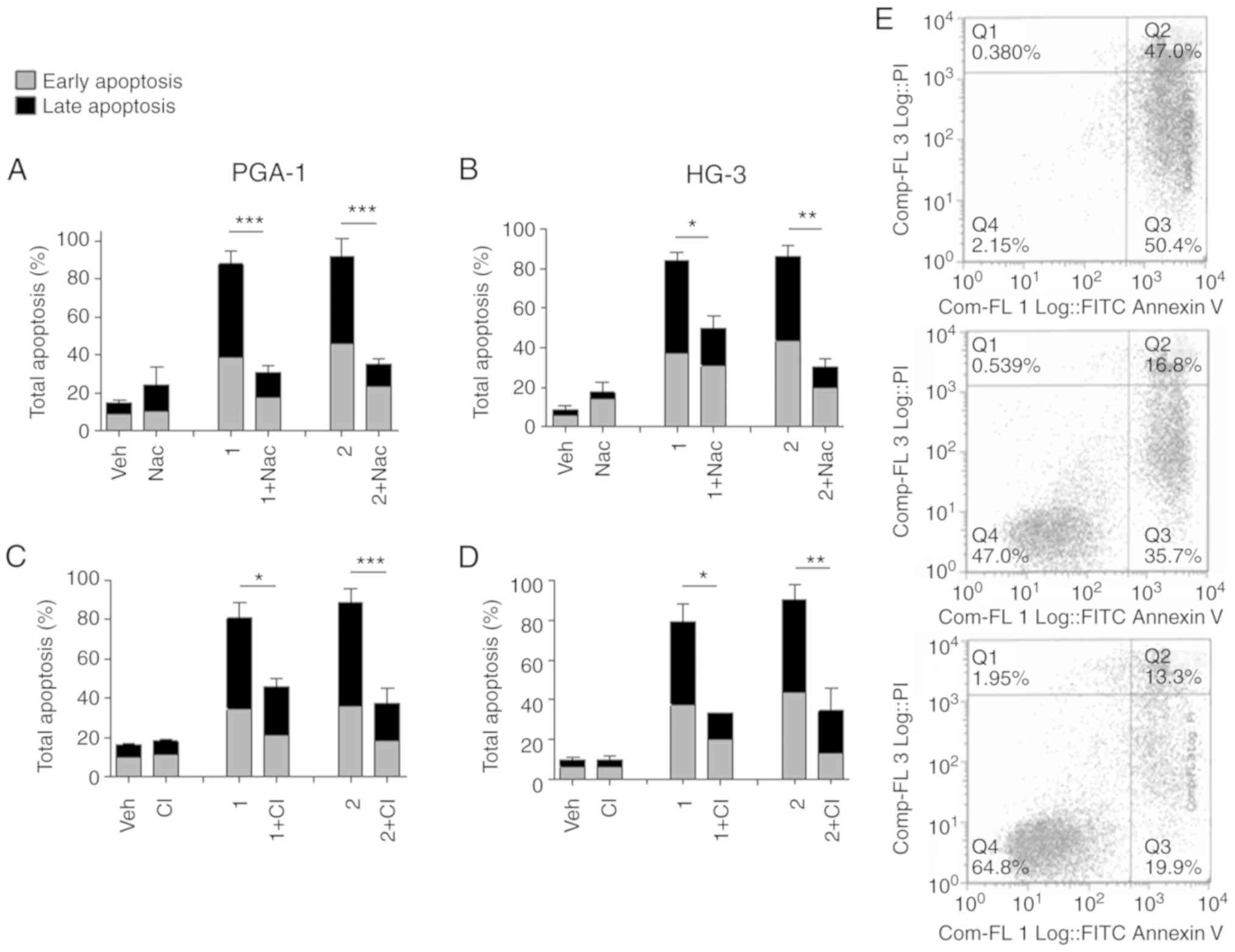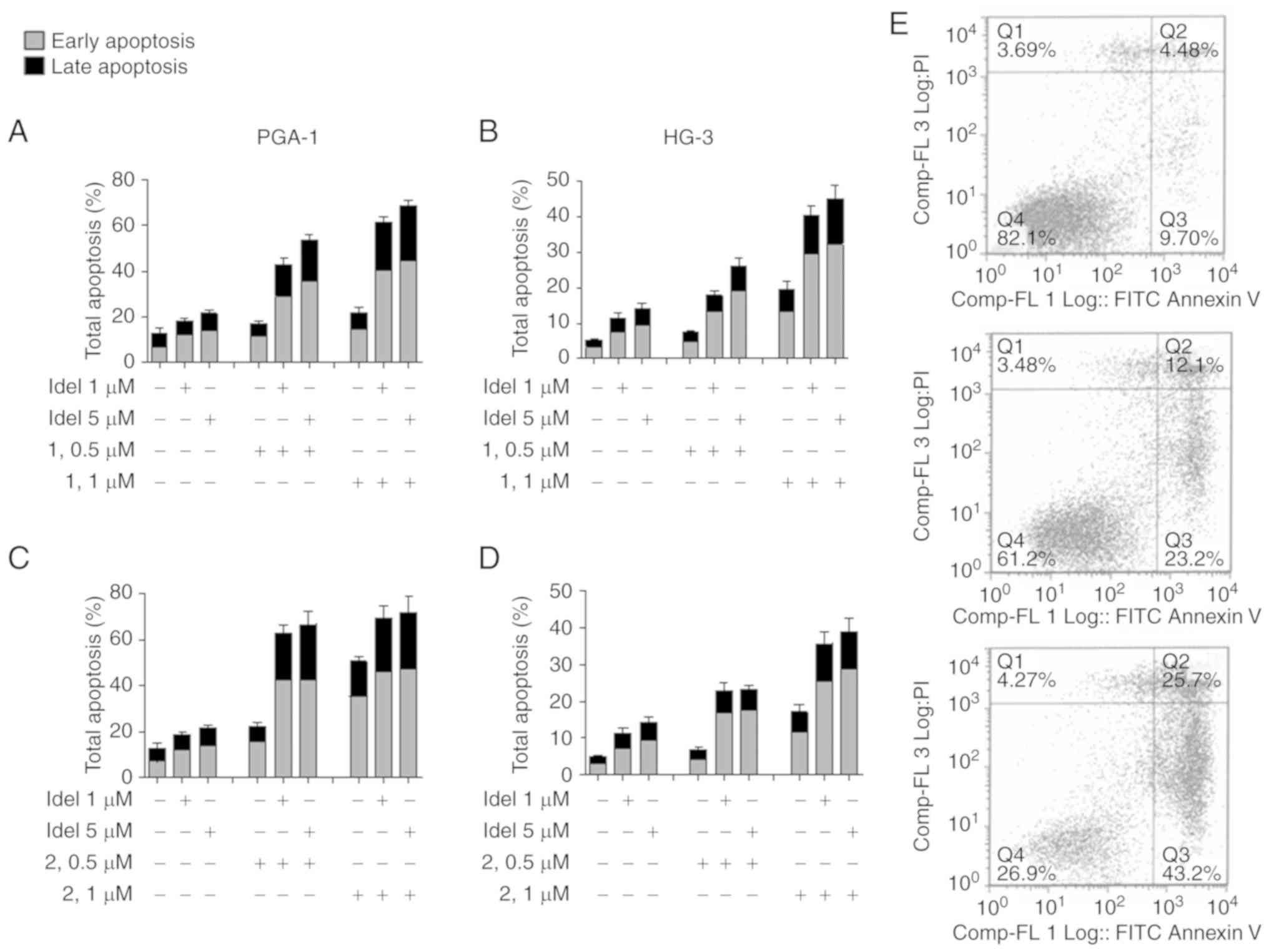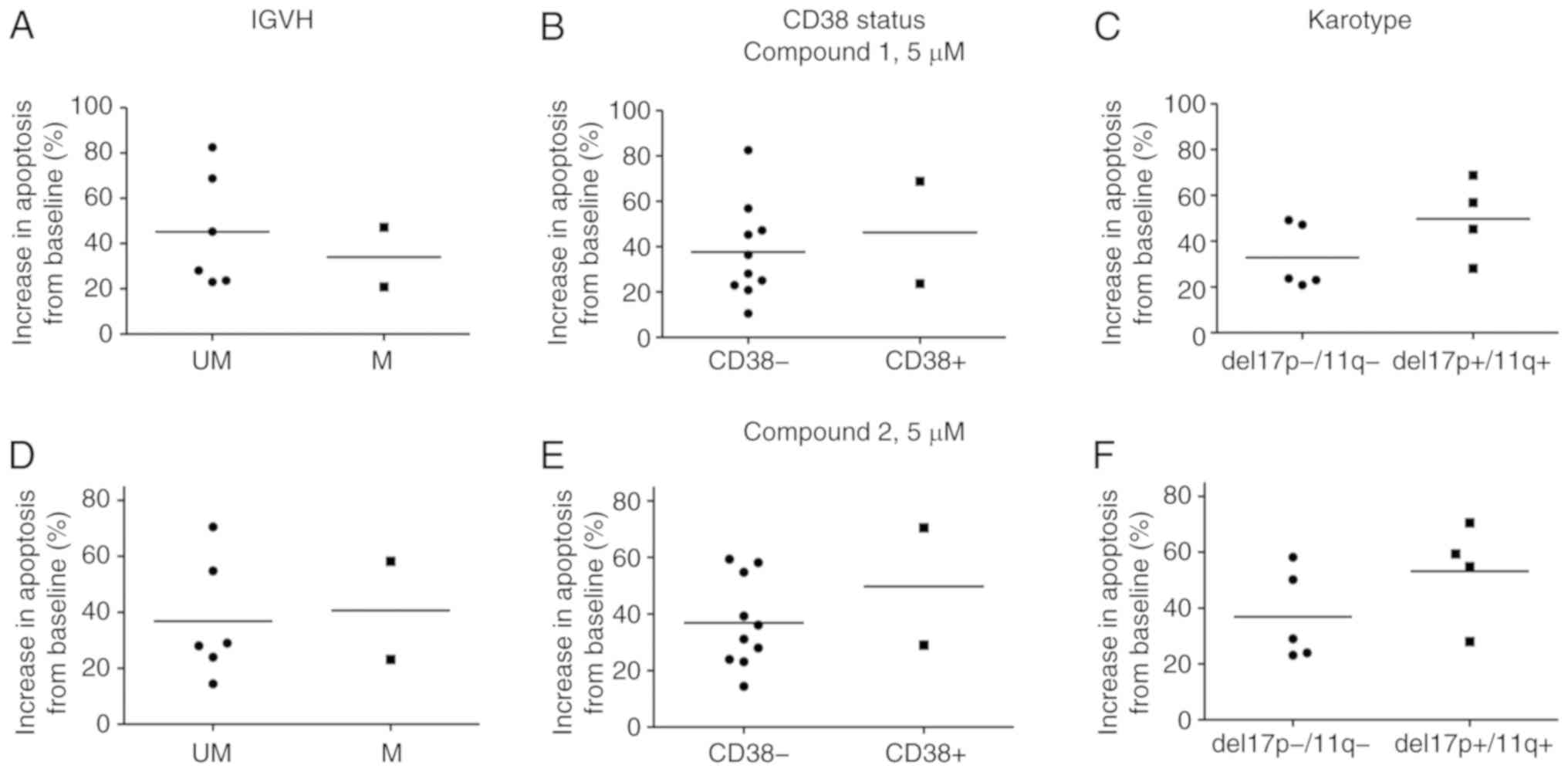|
1
|
Nabhan C and Rosen ST: Chronic lymphocytic
leukemia: A clinical review. JAMA. 312:2265–2276. 2014. View Article : Google Scholar : PubMed/NCBI
|
|
2
|
Puiggros A, Blanco G and Espinet B:
Genetic abnormalities in chronic lymphocytic leukemia: Where we are
and where we go. Biomed Res Int. 2014:4359832014. View Article : Google Scholar : PubMed/NCBI
|
|
3
|
Skarbnik AP and Faderl S: The role of
combined fludarabine, cyclophosphamide and rituximab
chemoimmunotherapy in chronic lymphocytic leukemia: Current
evidence and controversies. Ther Adv Hematol. 8:99–105. 2017.
View Article : Google Scholar : PubMed/NCBI
|
|
4
|
Montgomery JA and Hewson K: Nucleosides of
2-fluoroadenine. J Med Chem. 12:498–504. 1969. View Article : Google Scholar : PubMed/NCBI
|
|
5
|
Hallek M: Chronic lymphocytic leukemia:
2017 update on diagnosis, risk stratification, and treatment. Am J
Hematol. 92:946–965. 2017. View Article : Google Scholar : PubMed/NCBI
|
|
6
|
Aalipour A and Advani RH: Bruton's
tyrosine kinase inhibitors and their clinical potential in the
treatment of B-cell malignancies: focus on ibrutinib. Ther Adv
Hematol. 5:121–133. 2014. View Article : Google Scholar : PubMed/NCBI
|
|
7
|
Shah A: New developments in the treatment
of chronic lymphocytic leukemia: role of obinutuzumab. Ther Clin
Risk Manag. 11:1113–1122. 2015. View Article : Google Scholar : PubMed/NCBI
|
|
8
|
Shah A and Mangaonkar A: Idelalisib: A
novel PI3Kδ inhibitor for chronic lymphocytic leukemia. Ann
Pharmacother. 49:1162–1170. 2015. View Article : Google Scholar : PubMed/NCBI
|
|
9
|
Duman RS: Neurobiology of stress,
depression, and rapid acting antidepressants: remodeling synaptic
connections. Depress Anxiety. 31:291–296. 2014. View Article : Google Scholar : PubMed/NCBI
|
|
10
|
Gold PW, Machado-Vieira R and Pavlatou MG:
Clinical and biochemical manifestations of depression: Relation to
the neurobiology of stress. Neural Plast. 2015:5819762015.
View Article : Google Scholar : PubMed/NCBI
|
|
11
|
Meredith EJ, Holder MJ, Chamba A, Challa
A, Drake-Lee A, Bunce CM, Drayson MT, Pilkington G, Blakely RD,
Dyer MJ, et al: The serotonin transporter (SLC6A4) is present in
B-cell clones of diverse malignant origin: probing a potential
antitumor target for psychotropics. FASEB J. 19:1187–1189. 2005.
View Article : Google Scholar : PubMed/NCBI
|
|
12
|
Xia Z, Bergstrand A, DePierre JW and
Nassberger L: The antidepressants imipramine, clomipramine, and
citalopram induce apoptosis in human acute myeloid leukemia HL-60
cells via caspase-3 activation. J Biochem Mol Toxicol. 13:338–347.
1999. View Article : Google Scholar : PubMed/NCBI
|
|
13
|
Xia Z, DePierre JW and Nassberger L:
Modulation of apoptosis induced by tricyclic antidepressants in
human peripheral lymphocytes. J Biochem Mol Toxicol. 12:115–123.
1998. View Article : Google Scholar : PubMed/NCBI
|
|
14
|
Xia Z, Karlsson H, De Pierre JW and
Nassberger L: Tricicylic antidepressants induce apoptosis in human
T-lymphocytes. Int J Immunopharmacol. 19:645–654. 1997. View Article : Google Scholar : PubMed/NCBI
|
|
15
|
Cloonan SM, Drozgowska A, Fayne D and
Williams DC: The antidepressants maprotiline and fluoxetine have
potent selective antiproliferative effects against Burkitt lymphoma
independently of the norepinephrine and serotonin transporters.
Leuk Lymphoma. 51:523–539. 2010. View Article : Google Scholar : PubMed/NCBI
|
|
16
|
Cloonan SM and Williams DC: The
antidepressants maprotiline and fluoxetine induce Type II
autophagic cell death in drug-resistant Burkitt's lymphoma. Int J
Cancer. 128:1712–1723. 2011. View Article : Google Scholar : PubMed/NCBI
|
|
17
|
Gandy MN, McIldowie M, Lewis K, Wasik AM,
Salomonczyk D, Wagg K, Millar ZA, Tindiglia D, Huot P, Johnston T,
et al: Redesigning the designer drug ecstasy: non-psychoactive MDMA
analogues exhibiting Burkitt's lymphoma cytotoxicity. Med Chem
Commun. 1:287–293. 2010. View Article : Google Scholar
|
|
18
|
McNamara YM, Bright SA, Byrne AJ, Cloonan
SM, McCabe T, Williams DC and Meegan MJ: Synthesis and
antiproliferative action of a novel series of maprotiline
analogues. Eur J Med Chem. 71:333–353. 2014. View Article : Google Scholar : PubMed/NCBI
|
|
19
|
Cloonan SM, Keating JJ, Butler SG, Knox
AJ, Jørgensen AM, Peters GH, Rai D, Corrigan D, Lloyd DG, Williams
DC, et al: Synthesis and serotonin transporter activity of
sulphur-substituted alpha-alkyl phenethylamines as a new class of
anticancer agents. Eur J Med Chem. 44:4862–4888. 2009. View Article : Google Scholar : PubMed/NCBI
|
|
20
|
McNamara YM, Cloonan SM, Knox AJ, Keating
JJ, Butler SG, Peters GH, Meegan MJ and Williams DC: Synthesis and
serotonin transporter activity of 1,3-bis(aryl)-2-nitro-1-propenes
as a new class of anticancer agents. Bioorg Med Chem. 19:1328–1348.
2011. View Article : Google Scholar : PubMed/NCBI
|
|
21
|
Kinjo T, Kowalczyk P, Kowalczyk M,
Walaszek Z, Slaga TJ and Hanausek M: Effects of desipramine on the
cell cycle and apoptosis in Ca3/7 mouse skin squamous carcinoma
cells. Int J Mol Med. 25:861–867. 2010.PubMed/NCBI
|
|
22
|
Parker KA, Glaysher S, Hurren J, Knight
LA, McCormick D, Suovouri A, Amberger-Murphy V, Pilkington GJ and
Cree IA: The effect of tricyclic antidepressants on cutaneous
melanoma cell lines and primary cell cultures. Anticancer Drugs.
23:65–69. 2012. View Article : Google Scholar : PubMed/NCBI
|
|
23
|
Jeon SH, Kim SH, Kim Y, Kim YS, Lim Y, Lee
YH and Shin SY: The tricyclic antidepressant imipramine induces
autophagic cell death in U-87MG glioma cells. Biochem Biophys Res
Commun. 413:311–317. 2011. View Article : Google Scholar : PubMed/NCBI
|
|
24
|
Lu T, Chou CT, Liang WZ, Yu CC, Chang HT,
Kuo CC, Chen WC, Kuo DH, Ho CM, Shieh P and Jan CR: Effect of
antidepressant doxepin on Ca2+ homeostasis and viability
in PC3 human prostate cancer cells. Chin J Physiol. 58:178–187.
2015.PubMed/NCBI
|
|
25
|
Wang YY, Chen YK, Hsu YL, Chiu WC, Tsai
CH, Hu SC, Hsieh PW and Yuan SF: Synthetic β-nitrostyrene
derivative CYT-Rx20 as inhibitor of oral cancer cell proliferation
and tumor growth through glutathione suppression and reactive
oxygen species induction. Head Neck. 39:1055–1064. 2017. View Article : Google Scholar : PubMed/NCBI
|
|
26
|
Tsai CH, Hung AC, Chen YY, Chiu YW, Hsieh
PW, Lee YC, Su YH, Chang PC, Hu SC and Yuan SF:
3′-hydroxy-4′-methoxy-β-methyl-β-nitrostyrene inhibits
tumorigenesis in colorectal cancer cells through ROS-mediated DNA
damage and mitochondrial dysfunction. Oncotarget. 8:18106–18117.
2017. View Article : Google Scholar : PubMed/NCBI
|
|
27
|
Messerschmitt PJ, Rettew AN, Schroeder NO,
Brookover RE, Jakatdar AP, Getty PJ and Greenfield EM: Osteosarcoma
phenotype is inhibited by 3,4-methylenedioxy-β-nitrostyrene.
Sarcoma. 2012:4797122012. View Article : Google Scholar : PubMed/NCBI
|
|
28
|
Calgarotto AK, da Silva Pereira GJ,
Bechara A, Paredes-Gamero EJ, Barbosa CM, Hirata H, de Souza
Queiroz ML, Smaili SS and Bincoletto C: Autophagy inhibited Ehrlich
ascitic tumor cells apoptosis induced by the nitrostyrene
derivative compounds: Relationship with cytosolic calcium
mobilization. Eur J Pharmacol. 678:6–14. 2012. View Article : Google Scholar : PubMed/NCBI
|
|
29
|
Pettit RK, Pettit GR, Hamel E, Hogan F,
Moser BR, Wolf S, Pon S, Chapuis JC and Schmidt JM:
E-Combretastatin and E-resveratrol structural modifications:
Antimicrobial and cancer cell growth inhibitory β-E-nitrostyrenes.
Bioorg Med Chem. 17:6606–6612. 2009. View Article : Google Scholar : PubMed/NCBI
|
|
30
|
He Y, Varadarajan S, Muñoz-Planillo R,
Burberry A, Nakamura Y and Núñez G:
3,4-Methylenedioxy-β-nitrostyrene inhibits NLRP3 inflammasome
activation by blocking assembly of the inflammasome. J Biol Chem.
289:1142–1150. 2014. View Article : Google Scholar : PubMed/NCBI
|
|
31
|
Carter KC, Finnon YS, Daeid NN, Robson DC
and Waddell R: The effect of nitrostyrene on cell proliferation and
macrophage immune responses. Immunopharmacol Immunotoxicol.
24:187–197. 2002. View Article : Google Scholar : PubMed/NCBI
|
|
32
|
Jain N, Yada D, Shaik TB, Vasantha G,
Reddy PS, Kalivendi SV and Sreedhar B: Synthesis and antitumor
evaluation of nitrovinyl biphenyls: anticancer agents based on
allocolchicines. Chem Med Chem. 6:859–868. 2011. View Article : Google Scholar : PubMed/NCBI
|
|
33
|
Kim JH, Kim JH, Lee GE, Lee JE and Chung
IK: Potent inhibition of human telomerase by nitrostyrene
derivatives. Mol Pharmacol. 63:1117–1124. 2003. View Article : Google Scholar : PubMed/NCBI
|
|
34
|
Park J and Pei D: trans-Beta-nitrostyrene
derivatives as slow-binding inhibitors of protein tyrosine
phosphatases. Bioche-mistry. 43:15014–15021. 2004. View Article : Google Scholar
|
|
35
|
Villar JA, Lima FT, Veber CL, Oliveira AR,
Calgarotto AK, Marangoni S and da Silva SL: Synthesis and
evaluation of nitrostyrene derivative compounds, new snake venom
phospholipase A2 inhibitors. Toxicon. 51:1467–1478. 2008.
View Article : Google Scholar : PubMed/NCBI
|
|
36
|
Byrne AJ, Bright SA, Fayne D, McKeown JP,
McCabe T, Twamley B, Williams C and Meegan MJ: Synthesis,
antiproliferative and pro-apoptotic effects of nitrostyrenes and
related compounds in Burkitt's lymphoma. Med Chem. 14:181–199.
2018. View Article : Google Scholar : PubMed/NCBI
|
|
37
|
Lanemo Myhrinder A, Hellqvist E, Sidorova
E, Söderberg A, Baxendale H, Dahle C, Willander K, Tobin G, Bäckman
E, Söderberg O, et al: A new perspective: molecular motifs on
oxidized LDL, apoptotic cells, and bacteria are targets for chronic
lymphocytic leukemia antibodies. Blood. 111:3838–3848. 2008.
View Article : Google Scholar : PubMed/NCBI
|
|
38
|
Chou TC and Talalay P: Quantitative
analysis of dose-effect relationships: the combined effects of
multiple drugs or enzyme inhibitors. Adv Enzyme Regul. 22:27–55.
1984. View Article : Google Scholar : PubMed/NCBI
|
|
39
|
McElligott AM, Maginn EN, Greene LM,
McGuckin S, Hayat A, Browne PV, Butini S, Campiani G, Catherwood
MA, Vandenberghe E, et al: The novel tubulin-targeting agent
pyrrolo-1,5-benzoxazepine-15 induces apoptosis in poor prognostic
subgroups of chronic lymphocytic leukemia. Cancer Res.
69:8366–8375. 2009. View Article : Google Scholar : PubMed/NCBI
|
|
40
|
Werner JM, Eger K and Jürgen Steinfelder
H: Comparison of the rapid pro-apoptotic effect of
trans-beta-nitrostyrenes with delayed apoptosis induced by the
standard agent 5-fluorouracil in colon cancer cells. Apoptosis.
12:235–246. 2007. View Article : Google Scholar : PubMed/NCBI
|
|
41
|
Rahmani-Nezhad S, Safavi M, Pordeli M,
Ardestani SK, Khosravani L, Pourshojaei Y, Mahdavi M, Emami S,
Foroumadi A and Shafiee A: Synthesis, in vitro cytotoxicity and
apoptosis inducing study of 2-aryl-3-nitro-2H-chromene derivatives
as potent anti-breast cancer agents. Eur J Med Chem. 86:562–569.
2014. View Article : Google Scholar : PubMed/NCBI
|
|
42
|
Burke RT, Meadows S, Loriaux MM, Currie
KS, Mitchell SA, Maciejewski P, Clarke AS, Dipaolo JA, Druker BJ,
Lannutti BJ and Spurgeon SE: A potential therapeutic strategy for
chronic lymphocytic leukemia by combining Idelalisib and GS-9973, a
novel spleen tyrosine kinase (Syk) inhibitor. Oncotarget.
5:908–915. 2014. View Article : Google Scholar : PubMed/NCBI
|
|
43
|
Bodo J, Zhao X, Sharma A, Hill BT, Portell
CA, Lannutti BJ, Almasan A and his ED: The phosphatidylinositol
3-kinases (PI3K) inhibitor GS-1101 synergistically potentiates
histone deacetylase inhibitor-induced proliferation inhibition and
apoptosis through the inactivation of PI3K and extracellular
signal-regulated kinase pathways. Br J Haematol. 163:72–80. 2013.
View Article : Google Scholar : PubMed/NCBI
|
|
44
|
de Rooij MF, Kuil A, Kater AP, Kersten MJ,
Pals ST and Spaargaren M: Ibrutinib and idelalisib synergistically
target BCR-controlled adhesion in MCL and CLL: A rationale for
combination therapy. Blood. 125:2306–2309. 2015. View Article : Google Scholar : PubMed/NCBI
|
|
45
|
Panayiotidis P, Jones D, Ganeshaguru K,
Foroni L and Hoffbrand AV: Human bone marrow stromal cells prevent
apoptosis and support the survival of chronic lymphocytic leukaemia
cells in vitro. Br J Haematol 92. 92:97–103. 1996. View Article : Google Scholar
|
|
46
|
Lagneaux L, Delforge A, De Bruyn C,
Bernier M and Bron D: Adhesion to bone marrow stroma inhibits
apoptosis of chronic lymphocytic leukemia cells. Leuk Lymphoma.
35:445–453. 1999. View Article : Google Scholar : PubMed/NCBI
|
|
47
|
Bartels M, Calgarotto AK, Martens AC, Maso
V, da Silva SL, Bierings MB, de Souza Queiroz ML and Coffer PJ:
Differential effects of nitrostyrene derivatives on myelopoiesis
involve regulation of C/EBPα and p38MAPK activity. PLoS One.
9:e905862014. View Article : Google Scholar : PubMed/NCBI
|















